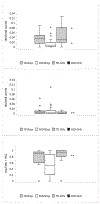Brief Report: "Um" Fillers Distinguish Children With and Without ASD
- PMID: 30171507
- PMCID: PMC6395582
- DOI: 10.1007/s10803-018-3736-1
Brief Report: "Um" Fillers Distinguish Children With and Without ASD
Abstract
Two laboratories have reported that children with ASD are less likely than their typical peers to fill pauses with um but their use of uh is unaffected (Irvine et al., J Autism Dev Disord 46(3):1061-1070, 2016; Gorman et al., Autism Res 9(8):854-865, 2016). In this brief report, we replicated this finding by comparing the discourse of 7-to-15-year-olds with ASD (N = 31) to that of their typically developing same-age peers (N = 32). The robustness of this easily documented difference in discourse suggests a potentially useful clinical marker of ASD.
Keywords: Autism Spectrum Disorder; Discourse; Disfluency; Fillers.
Conflict of interest statement
Karla McGregor declares that she has no conflict of interest. Rex Hadden declares that he has no conflict of interest.
Figures
Similar articles
-
Linguistic camouflage in girls with autism spectrum disorder.Mol Autism. 2017 Sep 30;8:48. doi: 10.1186/s13229-017-0164-6. eCollection 2017. Mol Autism. 2017. PMID: 29021889 Free PMC article.
-
Uh, Um, and Autism: Filler Disfluencies as Pragmatic Markers in Adolescents with Optimal Outcomes from Autism Spectrum Disorder.J Autism Dev Disord. 2016 Mar;46(3):1061-70. doi: 10.1007/s10803-015-2651-y. J Autism Dev Disord. 2016. PMID: 26586555 Free PMC article.
-
Uh and um in children with autism spectrum disorders or language impairment.Autism Res. 2016 Aug;9(8):854-65. doi: 10.1002/aur.1578. Epub 2016 Jan 22. Autism Res. 2016. PMID: 26800246 Free PMC article.
-
"Um" and "Uh" Usage Patterns in Children with Autism: Associations with Measures of Structural and Pragmatic Language Ability.J Autism Dev Disord. 2023 Aug;53(8):2986-2997. doi: 10.1007/s10803-022-05565-4. Epub 2022 Apr 30. J Autism Dev Disord. 2023. PMID: 35499654 Free PMC article.
-
Brief Report: Assessment of Intervention Effects on In Vivo Peer Interactions in Adolescents with Autism Spectrum Disorder (ASD).J Autism Dev Disord. 2016 Jun;46(6):2251-2259. doi: 10.1007/s10803-016-2738-0. J Autism Dev Disord. 2016. PMID: 26886470 Free PMC article. Clinical Trial.
Cited by
-
Can filled pauses be represented as linguistic items? Investigating the effect of exposure on the perception and production of um.Lang Speech. 2022 Jun;65(2):263-289. doi: 10.1177/00238309211011201. Epub 2021 May 24. Lang Speech. 2022. PMID: 34028288 Free PMC article.
-
A Pseudo-Value Approach to Analyze the Semantic Similarity of the Speech of Children With and Without Autism Spectrum Disorder.Front Psychol. 2021 Jul 21;12:668344. doi: 10.3389/fpsyg.2021.668344. eCollection 2021. Front Psychol. 2021. PMID: 34366986 Free PMC article.
-
Like, it's important: The frequency and use of the discourse marker like in older autistic children.Autism Dev Lang Impair. 2022 Sep 27;7:23969415221129132. doi: 10.1177/23969415221129132. eCollection 2022 Jan-Dec. Autism Dev Lang Impair. 2022. PMID: 36382079 Free PMC article.
-
Visuospatial information transfer and task self-assessment within and between autistic and non-autistic adults.PLoS One. 2025 Aug 14;20(8):e0329825. doi: 10.1371/journal.pone.0329825. eCollection 2025. PLoS One. 2025. PMID: 40811568 Free PMC article.
-
Quantitative Analysis of Narrative Discourse by Autistic Adults of Underrepresented Genders.Autism Adulthood. 2023 Jun 1;5(2):154-164. doi: 10.1089/aut.2021.0080. Epub 2023 Jun 13. Autism Adulthood. 2023. PMID: 37346991 Free PMC article.
References
-
- American Speech-Language-Hearing Association. (1990). Guidelines for screening for hearing impairments and middle ear disorders. Asha, 32(Suppl 2), 17–24. - PubMed
-
- Arciuli J, Mallard D, & Villar G (2010). “Um, I can tell you’re lying”: Linguistic markers of deception versus truth-telling in speech. Applied Psycholinguistics, 31(3), 397–411.
-
- Arnold JE, Fagnano M, & Tanenhaus MK (2003). Disfluencies signal theee, um, new information. Journal of Psycholinguistic Research, 32(1), 25–36. - PubMed
-
- Arnold JE, Hudson-Kam CL, & Tanenhaus MK (2007). If you say thee uh you are describing something hard: The on-line attribution of disfluency during reference comprehension. Journal of Experimental Psychology: Learning, Memory, and Cognition 33(5), 914–930. - PubMed
-
- Arnold JE, Tanenhaus MK, Altmann RJ, & Fagnano M (2004). The old and thee, uh, new: Disfluency and reference resolution. Psychological Science, 15(9), 578–582. - PubMed
MeSH terms
Grants and funding
LinkOut - more resources
Full Text Sources
Other Literature Sources
Medical


